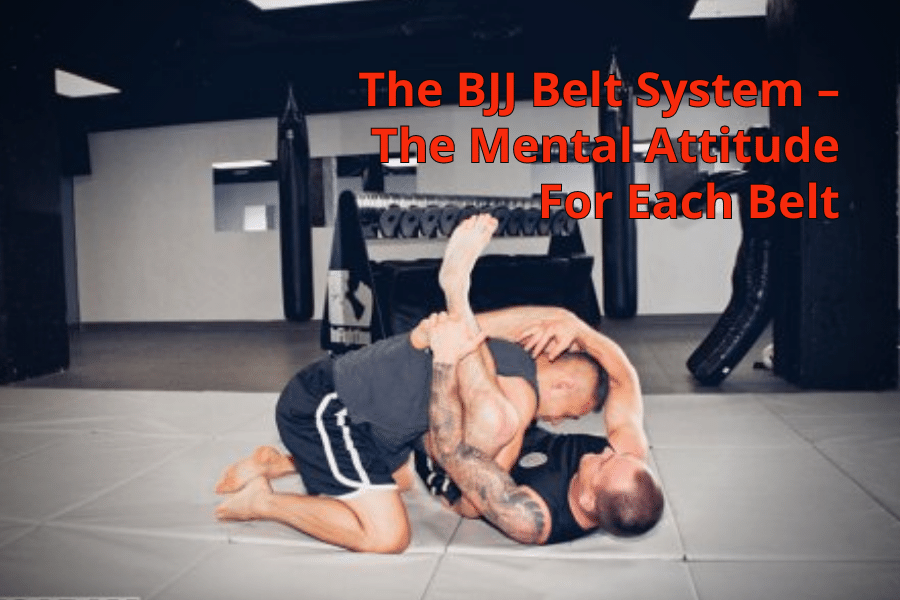
Table of Contents
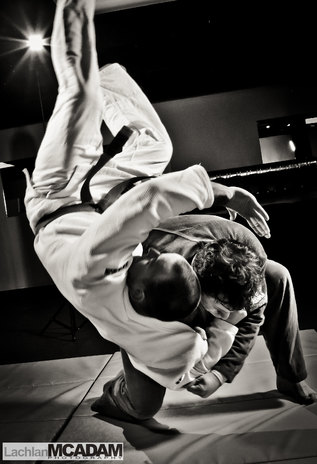
Today we are going to be taking a look at the different BJJ belts and what they represent.
One thing that is startling to beginners to Brazilian Jiu Jitsu, is that the belt system is much stricter than other forms of martial arts – with it often taking over 10 years to get a black belt in Brazilian Jiu Jitsu.
How we’re defining each BJJ belt level today is largely based on the learning stages associated with each belt. Each belt stage has specific indicators that determine the athlete’s mind set and skill level.
This breakdown of the belt levels of BJJ will help mitigate some of the frustrations some students feel when they’re stagnating at a particular belt. The key thing that I’m hoping to get across to BJJ students is that what they’re feeling and experiencing is completely normal at that particular skill level.
Having been greatly influenced by the work of Fitts & Posner with their theories on Motor Skill Acquisition and by Mihaly Csikszentmihalyi’s theory of Flow, it is also my hope with this article is to help BJJ coaches comprehend the belt levels as natural developmental stages for their athletes; so, that they can become better teachers and more understanding instructors.
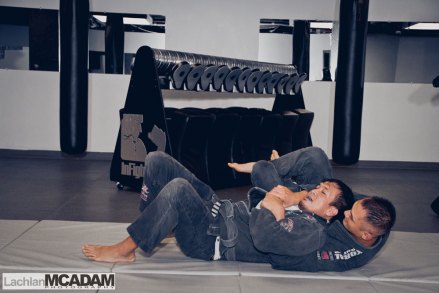
Coaching and teaching can be a frustrating process and unfortunately many instructors don’t realize how you give feedback to a white belt is different to how you give feedback to a brown belt.
As a quick initial summary of today’s article, here’s the best way to look at the different mind sets for each BJJ belt level:
White belt– Unconscious incompetence. You don’t know what you don’t know.
Blue belt– Conscious incompetence. You know what you don’t know.
Purple belt– Conscious competence. You know what to do.
Brown belt– Unconscious competence. You do what you know.
Black belt– You’re just conscious. You’re indifferent to competence or incompetence. You do Jiu Jitsu because you love it. Tapping people out is not the goal. If you get tapped out- no big deal. Just doing Jiu Jitsu becomes its own reward.
BJJ Belt System: White Belt
The first belt, it all starts here. You will be a complete beginner, learning the sport from a blank canvas. The goal is to create a frame of reference for all of the future things you will learn. You’re attaining the fundamental knowledge and movement patterns on which all of your skills are based upon.
The white belt is a highly cognitive stage in your learning; meaning, most of your energy and attention will be placed on how to do the technique. Each movement will be attached to a thought. You will be verbalizing each sequence of the technique in your head. You’ll need to be told what to do and coached on how to do it. You’ll largely need the help of other people at this stage.
As a white belt, you’ll be spending most of your time just gathering information. Learning what to do and how to do it and why you’re doing it.
Unconsciously Incompetent
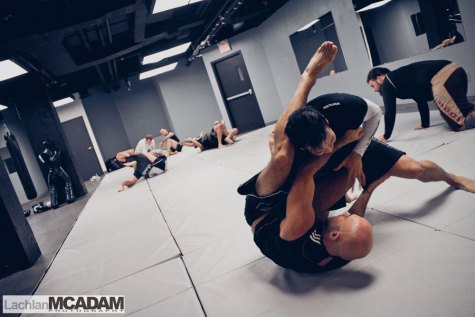
You’ll be unconsciously incompetent because there’s so much you don’t know.
You’ll be spending most of your time ingesting information and organizing it so that the movements seem logical to you.
Ultimately, fighting is logical. There should be a cogent reason why you’re doing what you’re doing. You can figure it out mostly on your own but it would simply take too long. A coach is there to help you attain the information as quickly and as cohesively as possible and to mitigate the naturally frustrating aspects of this learning stage.
Your performance as a white belt will be inconsistent. You’ll be frustrated, confused and you’ll feel complete uncertainty towards everything that you’re doing; however, solace can be found in the fact that this is completely natural for everybody at the white belt stage of learning. We all go through it. The white belt is the most difficult stage during the BJJ journey. You’ll spend most of your time on the bottom and you’ll spend most of your time tapping out to more experienced training partners.
You’ll feel like you’re drowning as everything you do will feel as if it’s working against you.
The white belt is a rite of passage that all BJJ practitioners go through. No one is above the process. Every person with a colour belt in BJJ was first the nail before they became the hammer.
Despite all of the frustrations associated with being a complete beginner, it’s also the stage where you’ll feel the greatest degree of development. As a white belt, every class will feel like a complete game changer for you. You’ll see and feel huge gains in your skill with each and every week and every technique that is shown to you will seem like a revelation. This is the part where you’ll start to fall in love with Jiu Jitsu.
BJJ Belt System: Blue Belt
Students at the blue belt level will have a strong idea as to how to attack and have one “go to” attack in every position.
Students awarded a blue belt will have a decent defense and are able to escape from every major position.
As a blue belt, you’ll become consciously incompetent. You’ll still be making fundamental mistakes but you’ve retained enough information to know what to do and how to fix it. As a blue belt you may realize that there’s techniques that may be missing in your game or critical details in your technique that may need to be cleaned up.
When you’re a blue belt you’ll start to become more independent with your skill development. Because you have a deeper understanding of Jiu Jitsu, you’ll be able to ask questions and have a dialogue with your training partners and coaches as an attempt to patch up holes in your game. As a blue belt you’ll be able to see your own mistakes.
Functionalizing your Jiu Jitsu will be the greatest hurdle for the blue belt. Finding the right timing, positional configuration and circumstance when executing your techniques will be the most frustrating part of this learning stage. Blue belts know what to do; but, it’s just tough doing what they know.
Consciously Incompetent
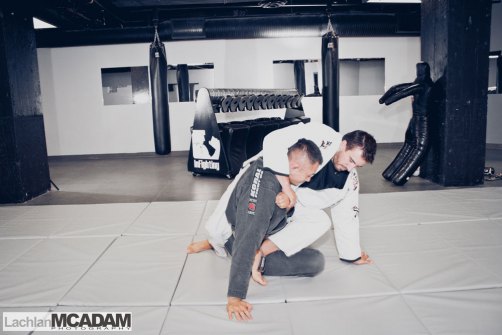
Your performance as a blue belt is still inconsistent. Some days you’ll feel like you’re tearing up the mats and then some days you feel like a fish on a bicycle. This can create an enormous amount of frustration for students. Dealing with the emotional highs and low with Jiu Jitsu is a part of the learning process. You can’t learn how to swim without getting wet.
It’s important for coaches and students to understand that performance inconsistencies are highly typical at the blue belt stage. The key solution for coaches is to reinforce the basics and to force feed fundamental techniques to their blue belt students. When fundamental techniques and movement patterns are habitualized, blue belt athletes will find greater consistency with their performance.
As a blue belt, your attacks are well executed but they’re still disjointed and lacking smoothness.
When blue belts are starting to chain together their attacks- armbar into triangle or kimura into bump sweep- they’re getting close to a purple belt.
BJJ Belt System: Purple Belt
Movement and Momentum are the tenets of a purple belt.
You’ll be rolling with greater smoothness as a purple belt. This is the stage where you’ll move with your weight in the right place and you’ll discover how to manipulate your opponent’s momentum and weight to your advantage.
You will also learn to reduce wasted movements and eliminate superfluous actions that have been holding you back from becoming more fluid and efficient.
You will also further perfect your defense and will spend a lot of time on your weaker skill sets in Brazilian Jiu Jitsu. This part can be very frustrating for many people, as they spend a majority of their purple belt stage working on things they are not good at.
You should also be familiar with every Guard configuration and specialize in doing one or two perfectly.
As a purple belt, you’ll begin to combine your actions. You’ll do simple compound attacks like armbar into triangle choke.
Your performance gains will be smaller and less obvious than they were at the white belt and blue belt stages. This can be frustrating for many purple belts as the feeling that they are not getting any better and that they are plateauing quickly sets in.
It’s critical for coaches to help their purple belt students understand that their performance gains won’t be as drastic as they were before and that many of their improvements will come from subtle improvements found in achieving higher efficiency, greater fluidity and a stronger understanding of momentum and weight.
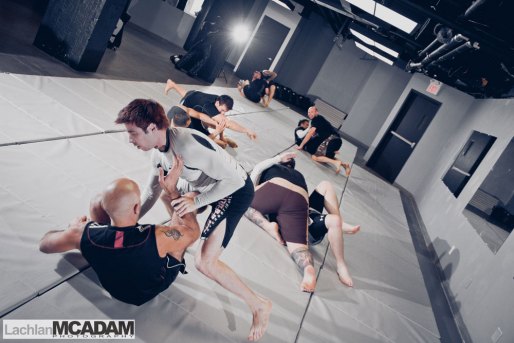
Consciously Competent
As a purple belt, you’ll be consciously competent, knowing what to do and when to do it. Purple belts will have keen recognition of the correct circumstances and positions to execute their techniques.
As well, you be making your own adjustments and applying more self-coaching as your knowledge base is much deeper and broader than it was when you were a white and blue belt. You’ll be less dependent on your coach for answers and your relationship with your coach will be more akin to problem solving and an exchange of ideas rather than a monologue where only the coach talks and you just sit and listen.
The key goal at purple belt is to attain a higher degree of smoothness. As a purple belt the divide between knowing what to do and doing what you know is starting to narrow.
Brown Belt
The last belt before the black belt, there should be very few moves or positions that are unfamiliar to you at brown belt level. At this belt, you should also be ready to teach the art of BJJ to others.
Furthermore, you should be almost unbeatable from top positions and have well developed counters for just about every move an opponent throws at you. Likewise, you will also have several signature moves you’ve developed which work on almost any opponent.
As a brown belt, you’re starting to string together complex attacks- armbar, triangle into omoplata. Smoothness and efficiency is the foundation of your skill.
As a brown belt, you’ll almost entirely be a visual learner. You can see a new technique and almost immediately be able to replicate it.
As a coach, brown belts will be some of the easiest students to coach. You’ll be able to show them a move once or twice and they’ll be able to imitate it perfectly.
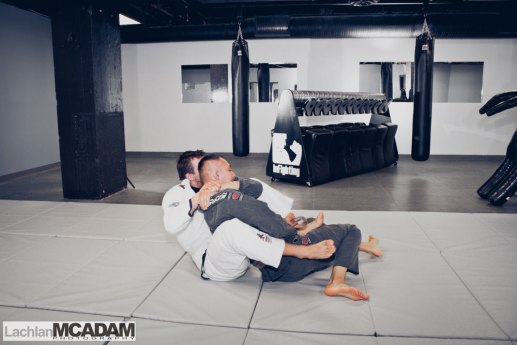
Unconsciously Competent
You are unconsciously competent as a brown belt. Your movements are automatic, smooth and graceful. As a white belt, you’ll need to mentally verbalize the process to hit each and every technique. Conversely, as a brown belt, you just do it- it’s completely automatic and it’s done entirely without thought.
You’ll have an automatic and immediate execution of movements and techniques, your mind will be free to focus on other things- counter attacks, follow ups and transitions. You’ll be able to apply real time changes to your tactics and techniques as the circumstances alter.
Zen masters call this Mushin or “no-mindness”.
Unfortunately, this mindlessness has a draw back. The expert sometimes has a tendency to let their mind wander when their movements are automatic to them. Focusing on negative images or on unproductive thoughts.
We’ve all seen professional fighters who “choke” or high level athletes who complacently execute techniques with poor form.
Sloppiness and foggy concentration is a common disease for many high level practitioners. It’s important for coaches to be aware of this phenomenon amongst their brown belts and mitigate it.
At the brown belt level, coaches ought to focus on recognizing when their brown belt students are falling out of concentration while rolling. When there are pauses in their action, if they’re too docile or if they are not moving “with” their opponent- these are usually signs that the athlete is ruminating or daydreaming.
Coaches need to encourage their athletes to stay mentally engaged and highly focused during their matches.
As well, brown belts may start to develop sloppiness with their form. Coaches need to stay vigilant about reinforcing the fundamentals with everyone including the brown belts. Brown belts may develop a “I already know this and I don’t need to train it” attitude. This is completely natural for a high level athlete to dismiss training the basics and causes a lot of stress for many coaches.
Coaches need to come in and encourage their brown belts that in order to improve their winning percentages they need to drill the basics in order to achieve the finest technique.
For brown belts, their performance will be highly consistent. Months may go by before a brown belt gets tapped out and when it happens it can be emotionally devastating for them because it happens so infrequently. For the white belt or the blue belt, getting tapped out is just another day on the mats.
Complacency, emotional fragility, foggy concentration and lack of focus are common pitfalls for the brown belt.
Black Belt
After years of studying and training, this is the holy grail of all martial arts, the black belt holder is a true master of BJJ. You should have full control over your body, your movements and your ego.
As a black belt, your moves are near-perfect, graceful and should look inspirational from the audience’s perspective. Just as you would expect, a black belt means you are an expert at Jiu Jitsu.
Your understanding of Jiu Jitsu is deep, precise and highly technical. At the black belt level, you ought to be developing and creating your own techniques and attacks. As well, attacks and defenses are done reflexively and without thought. Black belts see excessive strength as the enemy and always look to find the greatest amount of leverage with every technique.
Your mindset and attitude for Jiu Jitsu is also at the highest level. Black belts are focused on the process. For Jiu Jitsu black belts, the activity of doing Jiu Jitsu is the reward. Black belts are enamored with the process of rolling- moving with grace, flowing in and out of attacks, transitioning reflexively, problem solving in real time.
As a black belt, you’ll find joy not in tapping people out; but, in moving with absolute efficiency and with finding the precise timing to execute every technique.
Attitudes of lower belts are focused on the outcome- getting the submission or not getting tapped out- in order to win, there must also be a loser. When you’re outcome dependent, you become frustrated easier and you’ll have anxiety when you’re on the mat.
Black belts are not the slightest bit outcome dependent.
Let’s use skiing as an example. Is there an outcome when you’re skiing?
When you’re skiing, the reward is skiing – joy and happiness are intrinsic to the activity. There’s no winning when you’re on the mountain. There’s nothing to dominate when you’re cutting through the snow.
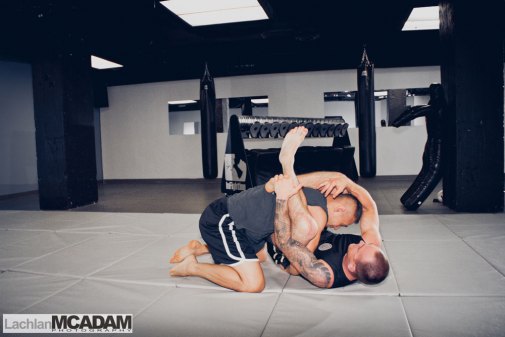
Or how about dining at an exquisite restaurant? When you’re out at an amazing restaurant, pure joy is found within the activity. You’re not trying to be the best patron. And you’re not trying to out eat the person next to you. There’s no outcome that you’re trying to achieve. You find happiness in just dining at the restaurant.
Black belts see Jiu Jitsu in the same way. Pure joy is found in the process and in the activity. Rolling in and of itself is the reward. There’s no winning and there’s no losing. There’s only joy.
As a black belt, your need for an outcome is gone; instead, your focus is in the smoothness of your transitions and how well you yield and dissolve your opponent’s attacks and how well you exercise the principles of leverage and weight distribution.
Black belts realize that when you’re not focused on submissions that’s when the submissions will occur.
Black belts are also in love with the learning process. Lower belts are always looking for a destination. It’s the “are we there yet?” disease. Lower belts are always wondering when they’re getting their next promotion.
Also, lower belts are focused on some level of completion. “I’m going to bust my ass just for the next 3 months because I want to get my blue belt before Xmas. After that, I’m going to chill for bit.”
Black belts understand that there is no destination- the journey never ends.
And black belts understand that there is no completion- training hard diligently and regularly is just how you live your life.
The black belt knows that everybody needs to return to the white belt level and consistently learn new things, break bad habits and remold new, more effective habits. Improvement means change. To change means to learn and to learn means to be a white belt all over again.
Getting your black belt is not about arriving at a destination or the completion of a long journey. A black belt is about falling in love with being a constant white belt.



